Assignment:
QUESTION 1. Assume that coffee and tea are substitutes. When the price of coffee increases
1. the demand for tea increases.
2. the supply of tea decreases.
3. the demand for tea decreases.
4. the supply of tea increases.
QUESTION 2. Assume that tortilla chips and salsa are complements. When the price of tortilla chips decreases
1. the supply of salsa decreases.
2. the demand for salsa increases.
3. the demand for salsa decreases.
4. the demand for tortilla chips decreases.
QUESTION 3
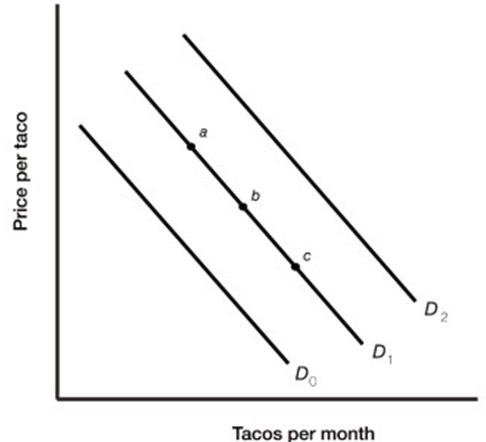
Figure illustrates the demand for tacos. A successful advertising campaign to sell tacos would bring about a movement from
1. point a to point b.
2. point c to point b.
3. D2 to D1.
4. D0 to D1.
QUESTION 4
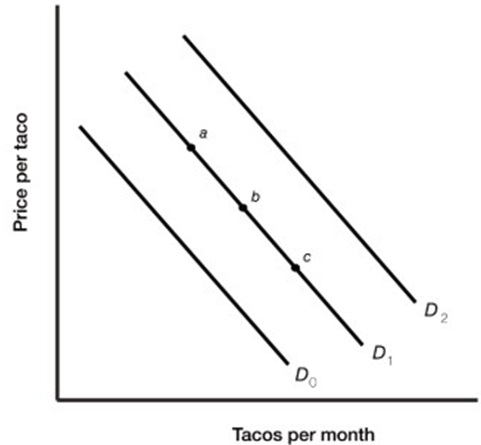
Figure illustrates the demand for tacos. An increase in the number of consumers in the market would bring about a movement from
1. point a to point b.
2. point c to point a.
3. D2 to D1.
4. D0 to D2.
QUESTION 5
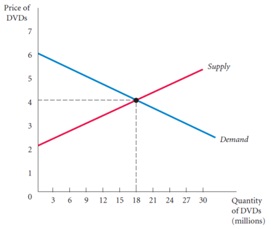
Figure illustrates the demand for tacos. Assume tacos are a normal good. An increase in income would bring about a movement from
1. point a to point b.
2. point c to point b.
3. D2 to D1.
4. D0 to D1.
QUESTION 6
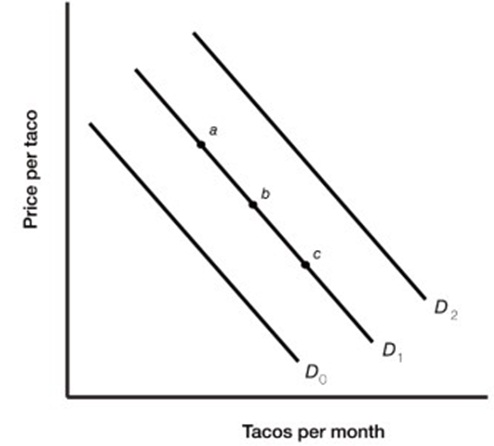
Figure illustrates the demand for tacos. Assume tacos are an inferior good. An increase in income would bring about a movement from
1. point a to point b.
2. point c to point b.
3. D2 to D1.
4. D0 to D1.
QUESTION 7
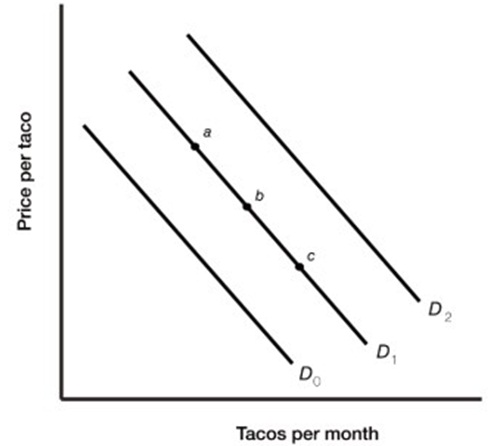
Figure illustrates the demand for tacos. If people expect the price of tacos to decrease in the near future, this would most likely bring about a movement from
1. point a to point b.
2. point c to point a.
3. D2 to D0.
4. D0 to D1.
QUESTION 8. If demand for a product increases, ceteris paribus, the equilibrium
1. price decreases.
2. price remains unchanged.
3. quantity decreases.
4. price increases.
QUESTION 9. Suppose that a market for a product is in equilibrium at a price of $3 per unit. At any price below $3 per unit
1. the quantity demanded of the product will be less than the quantity supplied of that product.
2. there will be an excess demand for the product.
3. there will be an excess supply of the product.
4. there will be a surplus of that product.
QUESTION 10. Suppose that a market for a product is in equilibrium at a price of $5 per unit. At any price above $5 per unit
1. there will be an excess demand for the product.
2. the quantity supplied of the product will be less than the quantity demanded of that product.
3. there will be a shortage of that product.
4. there will be an excess supply of the product.
QUESTION 11. Suppose that consumers expect that the price of a product will increase in the future. The result is that
1. the current supply of the product increases.
2. the current demand for the product decreases.
3. the current demand for the product increases.
4. the current supply of the product decreases.
QUESTION 12. Suppose that in October the price of a cup of cafe latte was $2.50 and 400 lattes were consumed. In November the price of a latte was $2.00 and 300 lattes were consumed. What might have caused this change?
1. The price of coffee beans (an input of production of cafe lattes) fell.
2. The price of tea (a substitute for cafe lattes) fell.
3. The price of coffee beans (an input of production of cafe lattes) rose.
4. The price of tea (a substitute for cafe lattes) rose.
QUESTION 13. Suppose that the quantity of cars demanded exceeds the quantity of cars supplied. We would expect that
1. the price of cars will increase.
2. the price of cars will decrease.
3. the supply will increase (supply will shift to the right) to meet the demand.
4. the demand will decrease (demand will shift to the left) to meet the supply.
QUESTION 14. Suppose that the quantity of cars supplied exceeds the quantity of cars demanded. We would expect that
1. the price of cars will increase.
2. the price of cars will decrease.
3. the supply will increase (supply will shift to the right) to meet the demand.
4. the demand will decrease (demand will shift to the left) to meet the supply.
QUESTION 15. When the price of apples goes up
1. the quantity of apples demanded will decrease, ceteris paribus.
2. the demand for apples will increase, ceteris paribus.
3. the quantity of apples demanded will increase, ceteris paribus.
4. the demand for apples will decrease, ceteris paribus.